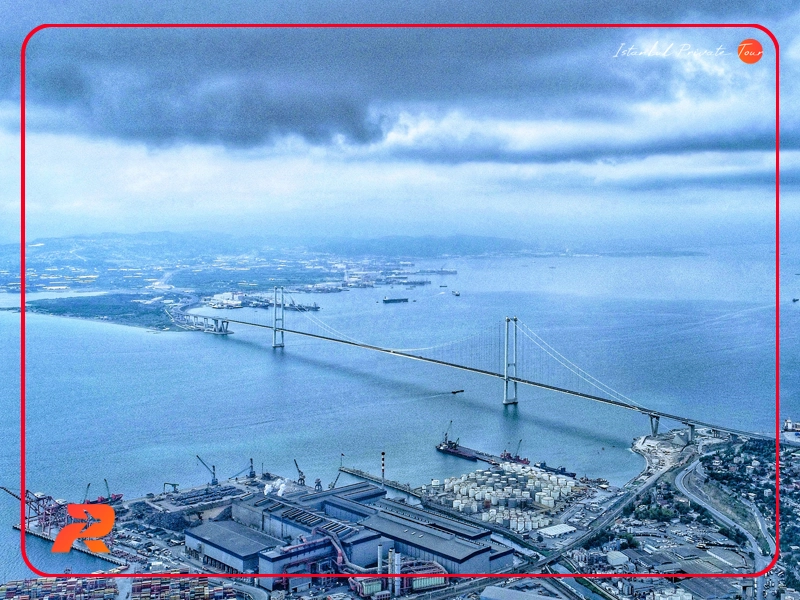Exploring the Bosphorus Bridge

The Bosphorus Bridge, also known as the 15 July Martyrs Bridge, is one of the most important landmarks in Istanbul, Turkey. Its significance lies in connecting the city's Asian and European sections across the famous Bosphorus Strait. Read on to learn about the value of the Bosphorus Bridge, the suspension bridge in Turkey, in a bustling city that never sleeps.

Information and History of Bosphorus Bridge
The Bosphorus Bridge, completed in 1973, is one of three suspension bridges spanning the Bosphorus Strait, linking the Black Sea to the Sea of Marmara. Designed by British engineers Gilbert Roberts and William Brown, the bridge's construction began in 1970 with 35 engineers and 400 workers, following a decision made in the 1950s during Prime Minister Adnan Menderes's tenure. This was due to the urgent need for a bridge to connect the city's sides and relieve pressure on boats, which were the primary mode of transportation.
Technical Specifications
The Bosphorus Bridge is 1,560 meters long and 33.4 meters wide, with towers reaching about 165 meters high. Its deck features aerodynamic properties and is suspended by steel cables.
Usage and Significance
The Bosphorus Bridge is a vital architectural landmark and a symbol of unity between Asia and Europe. It handles over 200,000 vehicles daily but is closed to pedestrian traffic. The bridge is important for the city’s economy and location.
- It is about 7 km from Taksim Square.
- It is 10 km from the Blue Mosque.
- It is 40 km from Istanbul Airport.
- It is 38 km from Sabiha Gökçen Airport.
Renaming the Bosphorus Bridge
In 2016, the bridge was renamed the 15 July Martyrs Bridge to honor the events of that date, which nearly caused significant turmoil in the country.
The Bosphorus Bridge remains a symbol of unity and stability, attracting tourists and visitors from around the world to witness this magnificent landmark.
Other Important Bridges in Istanbul
Fatih Sultan Mehmet Bridge

The second main bridge connecting Europe and Asia, built to relieve pressure from the Bosphorus Bridge and facilitate traffic across the strait.
Yavuz Sultan Selim Bridge

The largest of the three bridges, designed for both cars and trains, part of modern infrastructure projects aimed at improving city traffic and transportation.
Osmangazi Bridge

The fourth-largest suspension bridge in the world, spanning the Gulf of Izmit. It connects Istanbul and Izmir, reducing travel time between the two cities from 8 to 3 hours, boosting transportation, trade, and economic growth.
Galata Bridge

A historical and distinctive bridge crossing the Golden Horn, connecting Eminönü in Fatih to Karaköy in Beyoğlu. It has undergone many modifications over the years to keep pace with urban and transportation developments. The bridge facilitates easy access to markets, shops, and restaurants on both sides, enhancing economic activity in the area. Its design allows the middle section to be lifted for large vessels, and it is a popular spot for fishing and enjoying views of the Golden Horn.
Toll Fees for Istanbul Bridges (as of May 2024)
| Bridge | Vehicle Type | Fee (TRY) |
|---|---|---|
| Bosphorus Bridge | Private car | 24 |
| Light commercial vehicle | 30 | |
| Motorcycle | 10 | |
| Class 3 vehicle | 67 | |
| Class 4 vehicle | 132 | |
| Class 5 vehicle | 175 | |
| Fatih Sultan Mehmet Bridge | Private car | 24 |
| Light commercial vehicle | 30 | |
| Motorcycle | 10 | |
| Class 3 vehicle | 67 | |
| Class 4 vehicle | 132 | |
| Class 5 vehicle | 175 | |
| Yavuz Sultan Selim Bridge | Private car | 49 |
| Light commercial vehicle | 65 | |
| Three-axle vehicle | 120 | |
| Four/Five-axle vehicle | 305 | |
| Six-axle or more vehicle | 380 | |
| Motorcycle | 35 | |
| Osmangazi Bridge | Private car | 399 |
| Minibus | 640 | |
| Bus | 760 | |
| Truck | 1005 | |
| Trailer truck | 1270 | |
| Motorcycle | 280 |
Note: Prices may vary according to official updates. Galata Bridge allows free pedestrian crossing. Osmangazi Bridge has the highest toll due to its length and importance in connecting Istanbul and Izmir. Always check official sources for the most current prices and policies.
The Importance of the Bosphorus Area

Transportation: The Bosphorus area boasts excellent transportation facilities, including:
- Bosphorus Bridge: A vital suspension bridge.
- Marmaray Tunnel: An underwater metro tunnel opened in 2013.
- Eurasia Tunnel: A car tunnel opened in 2016.
Bosphorus Cruise: Enjoy the stunning skyline of Istanbul via boats that offer views of both the European and Asian sides, providing a unique cultural experience along this historic waterway. Ideal for romantic atmospheres and honeymooners, offering unforgettable photo opportunities.
Historic Landmarks: The area is rich in beautiful historic landmarks such as:
- Dolmabahçe Palace in Beşiktaş.
- Maiden’s Tower in Üsküdar.
- Galata Tower, Beylerbeyi Palace, Ortaköy Mosque, Rumeli Fortress, Anadolu Fortress, and Ottoman pasha mansions.
Tourism Excellence: The area is home to many luxurious restaurants such as:

- Ulus 29 known for Turkish and international cuisine.
- Sortie offering great entertainment options.
- Feriye providing a fine dining experience with stunning views.
Exclusive Neighborhoods: Several upscale neighborhoods overlook the strait, including:
- Beşiktaş, Ortaköy, Arnavutköy, Bebek, Emirgan, Tarabya, Yeniköy, İstinye, Sarıyer, Üsküdar, Kanlıca, Beykoz, Anadoluhisarı, Beylerbeyi, and Çengelköy.
Luxury Shopping Facilities: Many famous shopping centers like:

- Zorlu Center in Beşiktaş.
- Kanyon Mall in Levent.
- İstinye Park in Sarıyer.
Healthcare Facilities: The area hosts well-known hospitals such as:
- Acıbadem Hospital in Beşiktaş and Üsküdar.
- American Hospital in Nişantaşı.
- Florence Nightingale Hospital in Şişli.
Renowned Educational Institutions: The area features high-quality educational institutions like:
- Robert College in Arnavutköy.
- Üsküdar American Academy in Üsküdar.
- St. George’s Austrian High School in Karaköy.
Top Universities: The neighborhoods near the Bosphorus are home to prestigious universities such as:
- Boğaziçi University in Bebek.
- Istanbul Technical University in Maslak.
- Marmara University in Üsküdar and Kadıköy.
Ongoing Real Estate Development: There are many luxurious real estate projects like residential complexes and villas with Bosphorus views, in addition to commercial projects.
Famous Luxury Hotels in the Bosphorus Area

Istanbul is home to many luxurious hotels overlooking the Bosphorus Strait. Some of the most famous ones include:
- Çırağan Palace Kempinski: A unique location in an old Ottoman palace offering magnificent views and luxurious services.
- Four Seasons Bosphorus: A luxury hotel in a historic Ottoman palace providing stunning views and top-notch services.
- Shangri-La Bosphorus: Known for its luxurious design and central location on the Bosphorus, offering breathtaking views.
- The Ritz-Carlton Istanbul: Offers panoramic views of the city and the Bosphorus, providing luxurious services and a unique stay experience.
- Swissôtel The Bosphorus: Located on a hill in Beşiktaş, offering stunning views of the Bosphorus along with luxurious services and comprehensive facilities.
- Grand Hyatt Istanbul: Located near Taksim Square, offering views of the Bosphorus and luxurious services.
These are some of the famous hotels offering a luxurious experience and spectacular views of the Bosphorus in Istanbul.
Similar Posts

Balloons In Cappadocia
A dazzling experience awaits you by riding balloons in Cappadocia, a Turkish city where the sky is decorated with colorful balloons and it is filled with lovers of adventures and great heights.

Baghdad Street in Istanbul
Baghdad Street in Istanbul is a popular spot that combines shopping and entertainment, making it appealing year-round. This old street offers tourists a chance to enjoy a comprehensive tour filled


